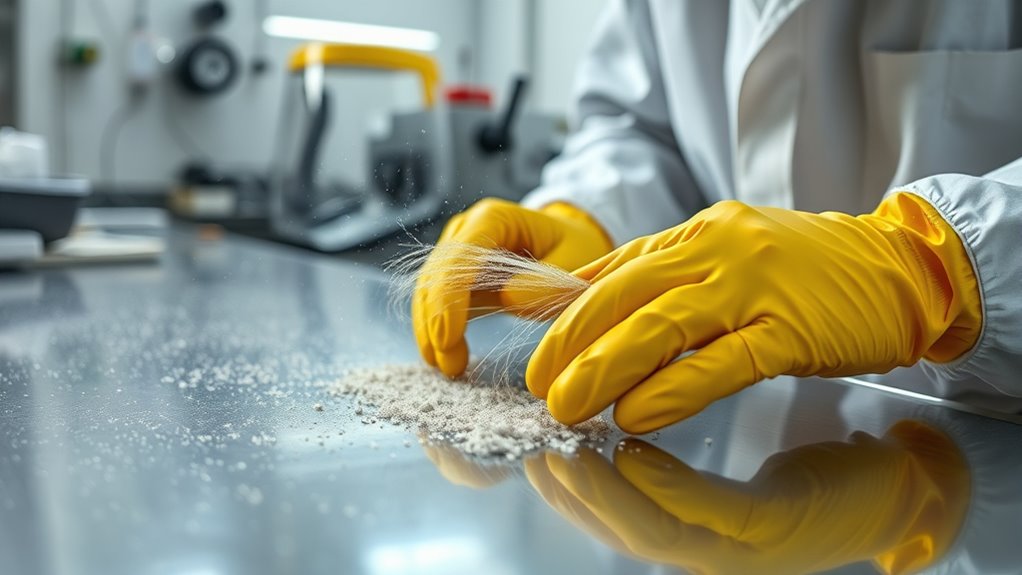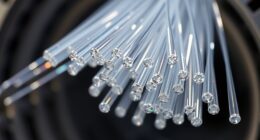Did you know that inhaling tiny fibers can increase your risk of respiratory issues over time? When working with fiber materials, safety should be your top priority to avoid health hazards. Proper PPE, good ventilation, and careful handling are essential steps you can’t overlook. Staying informed about specific fiber safety data sheets can make a significant difference. To protect yourself effectively, it’s important to understand the best practices—so, let’s explore what precautions you should take.
Key Takeaways
- Always wear appropriate PPE, including gloves, masks, and eye protection, to prevent skin and eye contact with fibers.
- Work in well-ventilated areas and use exhaust systems to minimize airborne fiber exposure.
- Handle fibers carefully, avoiding rushing, and clean the workspace regularly with HEPA-filtered vacuuming.
- Properly dispose of waste fibers in sealed containers and wash hands thoroughly after handling.
- Be aware of fiber type hazards by reviewing safety data sheets and tailoring precautions accordingly.

Working with fiber can be safe and efficient if you follow proper precautions. Fiber materials, especially when handled improperly, can pose health risks due to airborne particles and skin irritation. To protect yourself, always wear appropriate personal protective equipment (PPE). This includes gloves to prevent skin contact, long sleeves, and eye protection to shield your eyes from fibers that may become airborne. Respirators or masks are essential if you’re working in a confined space or generating a lot of dust, as they help prevent inhalation of fine fibers and dust particles. Remember, PPE acts as your first line of defense against potential health hazards, so invest in quality gear and use it consistently.
Wear PPE like gloves, long sleeves, and masks to stay safe when working with fiber materials.
Another critical aspect is maintaining proper ventilation in your workspace. Working in a well-ventilated area reduces the concentration of airborne fibers and dust, minimizing inhalation risks. If natural ventilation isn’t sufficient, consider using exhaust fans or air filtration systems designed for fiber work environments. Proper ventilation not only improves air quality but also helps disperse fibers quickly, preventing them from settling on surfaces or accumulating in the air. This is especially important when cutting, sanding, or manipulating fiber materials, as these actions tend to create airborne dust. By ensuring good airflow, you create a safer working environment for yourself and reduce the likelihood of respiratory issues. Additionally, understanding the health risks of airborne fibers can help you take more effective safety measures while working.
In addition to PPE and ventilation, it’s vital to follow proper handling techniques. Avoid rushing through tasks, as hurried movements can generate more dust and fibers. Keep your workspace clean by regularly sweeping or vacuuming with a HEPA-filter vacuum, which traps tiny particles instead of redistributing them into the air. When you finish working, dispose of waste fiber materials in sealed containers to prevent accidental exposure later. Washing your hands and face thoroughly after handling fiber materials further reduces any residual risk.
Staying informed about the specific type of fiber you’re working with is also crucial. Different fibers may have different safety requirements or handling instructions, so always review the manufacturer’s safety data sheets. If you’re working with synthetic or glass fibers, be extra cautious because these can be more irritating or hazardous than natural fibers.
Frequently Asked Questions
What Should I Do if I Experience a Fiber Optic Skin Contact Allergy?
If you experience a fiber allergy from skin contact, immediately stop working with fiber optics and wash the affected area thoroughly with soap and water. Use skin protection, like gloves, to prevent further contact. If symptoms persist, seek medical advice promptly. Remember, preventing fiber allergy requires proper skin protection and careful handling of fibers to avoid skin irritation or allergic reactions. Always prioritize safety to minimize health risks.
Are There Specific First Aid Steps for Fiber Optic Eye Exposure?
Imagine your fiber optic eye as a delicate windowpane suddenly struck by tiny sparks. If exposed, immediately rinse your eye with clean water or saline to wash out any fibers, never rub it. Seek urgent medical attention, as fiber optic eye exposure can cause irritation or damage. For first aid, keep your eye open and flush thoroughly, then visit an eye specialist promptly to prevent long-term injury.
How Often Should Safety Equipment Be Inspected for Fiber Work?
You should inspect your safety equipment regularly to guarantee it’s in good condition. Follow the manufacturer’s recommended inspection schedule, typically before each shift or daily. Prioritize equipment maintenance by checking for wear, damage, or malfunction, especially for eye protection and gloves. Regular inspections help prevent accidents and ensure your safety. Staying proactive with your inspection schedule keeps your gear reliable, giving you peace of mind while working with fiber.
Can Fiber Dust Cause Long-Term Respiratory Issues?
You might not realize it, but fiber dust can pose serious health risks over time. Prolonged exposure increases the chance of long-term respiratory issues, as inhaling fiber dust can irritate your lungs and cause chronic problems. Protect your health by using proper ventilation and respiratory gear. Ignoring these risks could lead to lasting damage. Stay vigilant, because your lungs deserve the best defense against fiber dust health hazards.
What Are the Best Practices for Disposing of Fiber Scraps Safely?
You should follow proper fiber waste management and scrap disposal procedures to guarantee safety. First, collect all fiber scraps in designated, sealed containers to prevent airborne dust. Wear protective gear while handling and disposing of scraps. Then, dispose of the waste according to your local regulations, either by recycling or sealing it for safe landfill disposal. This approach minimizes environmental impact and reduces health risks associated with fiber dust.
Conclusion
By following these safety precautions, you’ll protect yourself from potential health risks—after all, a clean, well-ventilated workspace isn’t just good practice, it’s essential. When you handle fibers carefully and wear the right PPE, you reduce hazards that might otherwise catch you off guard. Remember, safety isn’t just about rules; it’s about making sure that when you work with fibers, you stay healthy and safe—sometimes, safety precautions are the best safeguard you have.









